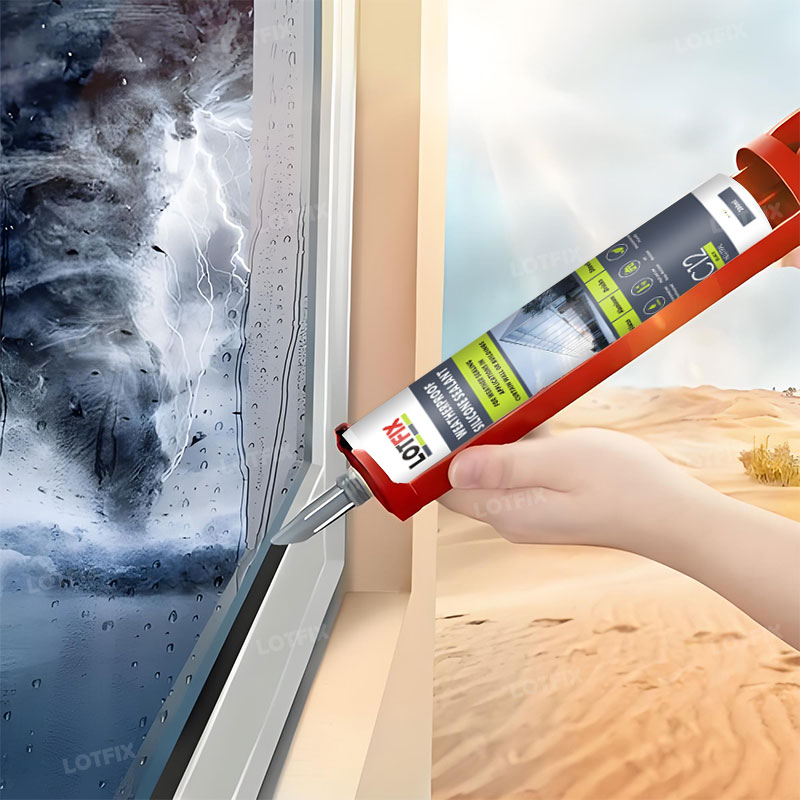Whether you’re installing new windows or replacing old ones, using silicone window sealant correctly is key to keeping out drafts, water, and moisture. It’s a small step that makes a big difference in your window’s long - term performance—here’s how to do it right, plus what you need to know about choosing the best product.

What Is Silicone window sealant?
Silicone Window Sealantis a flexible, durable adhesive made with organic silicon. When it’s exposed to air moisture, it cures into a rubber - like solid that bonds tightly to materials like glass, wood, aluminum, and vinyl. Unlike other sealants, it holds up well against extreme temperatures (from cold winters to hot summers), UV rays, and rain—making it perfect for window installation, where long - lasting weather protection is a must. A quality silicone window sealant also prevents air leaks, which can lower your energy bills by keeping your home’s temperature stable.
Types of Silicone Window Sealant on the Market
Not all silicone window sealants are the same—choosing the right type depends on your window material and installation needs:
Single - Component Neutral - Curing Sealant: The most popular pick for DIY and professional window installs. It cures with air moisture, has no strong odor, and won’t corrode sensitive materials like aluminum frames or painted surfaces. Many top silicone window sealant manufacturers, such as DOWSIL and Sika, offer this type as their “best silicone window sealant” for general use, since it works indoors and outdoors.
Single - Component Acid - Curing Sealant: Cheaper and faster - curing, but it releases a vinegar - like smell (from acetic acid) and can damage metal frames. It’s only good for glass - to - glass joints in non - metal windows (like some interior casements) and not recommended for most standard installations.
Two - Component Silicone Sealant: Mixes a base and curing agent before use. It’s stronger and more chemical - resistant than single - component options, so it’s often used by contractors for large - scale projects (like commercial window installations). Most homeowners won’t need this unless they’re installing heavy, large windows.
Mildew - Resistant Silicone Sealant: A specialty type with additives to fight mold and mildew. It’s ideal for windows in damp areas (like bathrooms or basements), where moisture buildup is common. Look for this if your window is near a shower or sink.
Step - by - Step: Using Silicone Sealant for Window Installation
1. Prep the Window and Surface
First, make sure your window and the installation area are clean and dry. Wipe down the window frame (wood, vinyl, or metal) and the wall opening with a cloth dampened with rubbing alcohol—this removes dirt, grease, and dust that could stop the sealant from sticking. If there’s old sealant left from a previous window, scrape it off with a putty knife. For a neat finish, apply masking tape along the edges of the frame and wall—this keeps the sealant from smearing onto unwanted areas.
2. Choose the Best Silicone Window Sealant and Tools
Pick a sealant that matches your project: For most residential window installs, go with a single - component neutral - curing silicone window sealant (check labels from trusted silicone window sealant manufacturers for “weatherproof” or “exterior - grade” claims—these mark the best silicone window sealant options). You’ll also need a caulk gun (manual works for small jobs) and a damp rag.
3. Apply the Sealant
Cut the tip of the sealant tube at a 45 - degree angle—make the opening slightly smaller than the gap between the window frame and the wall (usually 1/4 to 3/8 inch). Load the tube into the caulk gun, then hold the gun at a steady 45 - degree angle to the gap. Squeeze the trigger slowly and move the gun in a straight line, keeping even pressure. This ensures a smooth, consistent bead of sealant—no gaps or globs. If you need to stop mid - bead, lift the gun slightly to avoid dripping.
4. Smooth and Clean Up
Right after applying the sealant (before it starts to cure), use your finger (dipped in soapy water to prevent sticking) or a small putty knife to smooth the bead. This pushes the sealant into the gap and creates a tight bond. Then, peel off the masking tape immediately—if you wait too long, the sealant will stick to the tape. Wipe up any excess sealant with a damp rag.
5. Let It Cure
Curing time varies by product, but most silicone window sealants take 24 to 48 hours to fully dry. Don’t touch the sealant or expose the window to rain during this time. Once cured, the sealant will be firm but flexible—ready to protect your window for years.

